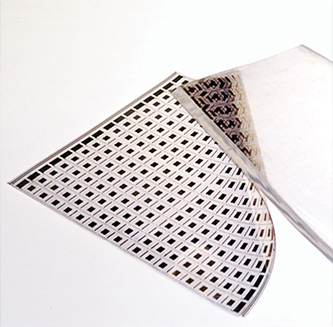She describes her research as a “logical progression” from her work in materials and processes for silicon chips for electronics and photonics.
“There are differences in terms of the precise chemistries but there are similarities from the standpoint of designing materials such as polymers to be able to do certain things,” Reichmanis says. “You can build devices out of polymer materials that can mimic the capabilities of silicon transistors. They aren’t nearly as powerful, but you don’t need the extent of memory and computing power that silicon provides for everything.”
The idea would be to create plastic devices in large sheets similar to the way newspapers are printed. The process would be additive, rather than subtractive, so less materials are wasted. Also, the temperatures needed to create polymer circuits are lower, requiring lower energy usage.
The result could possibly be electronics that flex or stretch. One example is credit cards that feature computer chips. The silicon chips are expensive to wire up. “So if we could design something that could cover the entire area of the credit card, we might have a cheaper fabrication process and a more sustainable one,” Reichmanis says.
“Your computer screen—instead of having it be glass, which can easily break if you drop it, could be polymer based. You could curve the surface, and if it’s flexible enough, you could roll it and carry it around like a magazine or newspaper.” The polymer alternatives are never going to replace silicon, she says, “but they create avenues for something silicon can’t do.”
Reichmanis and her team also are building on her research
on using polymeric materials to create higher-performing, longer- lasting and safer Lithium-ion batteries, which ultimately could make phones work longer between charges and electric vehicles go farther. Her collaborative research related to battery technologies is funded by a $750,000 grant for four years from the Center for Mesoscale Transport Processes, an Energy Frontier Research Center funded by the Department of Energy at Stony Brook University in New York. The project involves about a dozen universities across the country.
Collaboration is also at the heart of a revolutionary new project that has Reichmanis participating with scientists and engineers at 11 universities nationwide in an effort to transform the way we interact with light and, ultimately, transform devices and technologies that underpin much of modern life.
The project, spearheaded by the University of Washington and funded by the National Science Foundation, is part of IMOD, the Center for Integration of Modern Optoelectronic Materials on Demand. It has major implications for computing technology and optoelectronics that may find their way into realistic augmented reality and virtual reality displays.
As co-principal investigator and director for integrative partnerships, Reichmanis is building on her experience related to solution-phase processing of materials to precisely position Quantum Dots—semiconductor particles a few nanometers in size—and to integrate large-area Quantum Dots and perovskite thin films into devices at low temperatures, on both rigid and flexible substrates.
“My role is to explore how we can develop additive manufacturing-like processes that could be readily implemented,” she says. “We’re trying to design solution-based processes that are low-cost and not energy intensive, yet still create devices having robust performance.”
Elsa Reichmanis is a groundbreaking researcher and pioneer in the world of micro-lithography. She earned her Ph.D. in organic chemistry from Syracuse University.
Story by Jodi Duckett
Illustration by Neha Kavan






